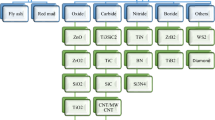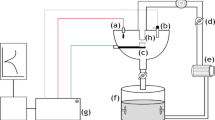Abstract
Tribological properties of rock/metal/ceramic/rock contact determine the behaviors of earth-moving activities. In this study, tribological performance of shale rock–alumina contact was examined. Experimental results show that friction of the contact is determined by liquid media at the interface. Tribofilm is found to form on the wear track. According to elementary analysis, hard materials in original shale rock or generated during sliding process aggregate on the surface, producing the tribofilm. Coefficient of friction between shale rock and alumina increases with load, which is attributed to increased real contact area under higher load. Findings in this research provide preliminary understanding of tribological properties of shale rock–alumina contact, which benefits further study of rock–ceramic contact and related industrial applications.










Similar content being viewed by others
References
Beste, U., Lundvall, A., Jacobson, S.: Micro-scratch evaluation of rock types—a means to comprehend rock drill wear. Tribol. Int. 37, 203–210 (2004)
Dougherty, P.S., Pudjoprawoto, R., Higgs, C.F.: On the role of bit cutter-on-rock tribometry to aid the drilling process for new energy resources. In: Proceedings of the ASME/STLE 2011 International Joint Tribology Conference, pp. 385–387. American Society of Mechanical Engineers, Los Angeles (2011)
Menezes, P.L., Lovell, M.R.: Influence of rock mechanical properties on the formation of rock fragments during cutting operation. In: Proceedings of the ASME/STLE International Joint Tribology Conference, pp. 253–255, American Society of Mechanical Engineers, Los Angeles (2011)
Goldsby, D.L., Tullis, T.E.: Low frictional strength of quartz rocks at subseismic slip rates. Geophys. Res. Lett. 29, 2521–2524 (2002)
Goldsby, D.L., Tullis, T.E.: Flash heating leads to low frictional strength of crustal rocks at earthquake slip rates. Science 334, 216–218 (2011)
Liang, F., Sayed, M., Al-Muntasheri, G., Chang, F.F.: Overview of existing proppant technologies and challenges. In: Proceedings of the SPE Middle East Oil & Gas Show and Conference, p. 172763, Society of Petroleum Engineers, Manama, Bahrain (2015)
Di Toro, G., Han, R., Hirose, T., De Paola, N., Nielsen, S., Mizoguchi, K., Ferri, F., Cocco, M., Shimamoto, T.: Fault lubrication during earthquakes. Nature 471, 494–498 (2011)
Reches, Z.E., Lockner, D.A.: Fault weakening and earthquake instability by powder lubrication. Nature 467, 452–455 (2010)
Tsutsumi, A., Shimamoto, T.: High-velocity frictional properties of gabbro. Geophys. Res. Lett. 24, 699–702 (1997)
Di Toro, G., Hirose, T., Nielsen, S., Pennacchioni, G., Shimamoto, T.: Natural and experimental evidence of melt lubrication of faults during earthquakes. Science 311, 647–649 (2006)
Di Toro, G., Goldsby, D.L., Tullis, T.E.: Friction falls towards zero in quartz rock as slip velocity approaches seismic rates. Nature 427, 436–439 (2004)
Dougherty, P.S., Pudjoprawoto, R., Higgs, C.F.: Bit cutter-on-rock tribometry: analyzing friction and rate-of-penetration for deep well drilling substrates. Tribol. Int. 77, 178–185 (2014)
Yu, C.M., Craig, K., Tichy, J.: Granular collision lubrication. J. Rheol. 38, 921–936 (1994)
Hirose, T., Bystricky, M.: Extreme dynamic weakening of faults during dehydration by coseismic shear heating. Geophys. Res. Lett. 34, L143111–L143115 (2007)
Yamakiri, H., Sasaki, S., Kurita, T., Kasashima, N.: Effects of laser surface texturing on friction behavior of silicon nitride under lubrication with water. Tribol. Int. 44, 579–584 (2011)
Xiao, H., Kim, S., He, X., Zhou, D., Li, C., Liang, H.: Friction pair evaluation of cartilage–diamond for partial joint repair. Carbon 80, 551–559 (2014)
Xiao, H., Ariyasinghe, N., He, X., Liang, H.: Tribological evaluation of porcine skin. Colloids Surf. B 116, 734–738 (2014)
Chen, M., Kato, K., Adachi, K.: The difference in running-in period and friction coefficient between self-mated Si3N4 and SiC under water lubrication. Tribol. Lett. 11, 23–28 (2001)
Liu, N., Wang, J., Chen, B., Han, G., Yan, F.: Effect of UHMWPE microparticles on the tribological performances of high-strength glass fabric/phenolic laminate composites under water lubrication. Tribol. Lett. 55, 253–260 (2014)
Sone, H., Zoback, M.D.: Mechanical properties of shale-gas reservoir rocks—part 1: static and dynamic elastic properties and anisotropy. Geophysics 78, D381–D392 (2013)
Acknowledgments
Support by National Natural Science Foundation of China (No. 51575529) and Science Foundation of China University of Petroleum, Beijing (Nos. 2462014YJRC049, 2462015YQ0401, and 2462015YQ0403), was acknowledged.
Author information
Authors and Affiliations
Corresponding authors
Rights and permissions
About this article
Cite this article
Xiao, H., Liu, S. & Wang, D. Tribological Properties of Sliding Shale Rock–Alumina Contact in Hydraulic Fracturing. Tribol Lett 62, 20 (2016). https://doi.org/10.1007/s11249-016-0667-x
Received:
Accepted:
Published:
DOI: https://doi.org/10.1007/s11249-016-0667-x




